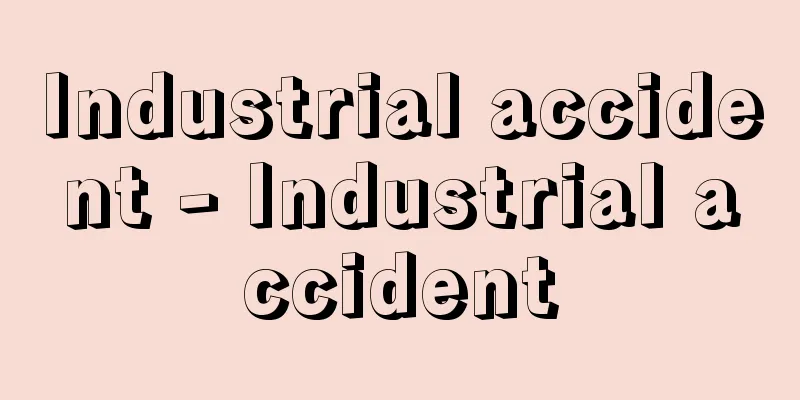Industrial accident - Industrial accident

|
An occupational accident that occurs when a worker (a person employed in a business or office, regardless of type of occupation, who is paid a wage) suffers from work-related injuries, illnesses, and deaths while performing their duties. It is abbreviated as "rosai." In the West, occupational accidents are called work accidents or occupational accidents, which literally translate to work accidents or occupational accidents, but in Japan accidents are often called "disasters." In a broad sense, injuries, illnesses, disabilities, and deaths that workers suffer while working are called "work-related accidents," injuries, illnesses, disabilities, and deaths that workers suffer while commuting are called "commuting accidents," and accidents caused by the illegal acts of third parties (those other than the state, employer, or the worker) are called "third-party accidents." In addition, there are various definitions of occupational diseases, including those that are delayed onset (diseases that develop slowly, such as pneumoconiosis, lead poisoning, and vibration disorders), food poisoning, and infectious diseases, which are excluded from occupational accidents, in conjunction with compensation systems and reporting obligations. In the narrow sense, an industrial accident is defined in Article 2 of the Industrial Safety and Health Act (Act No. 57 of 1972) as "an accident in which a worker is injured, becomes ill, or dies due to constructions, equipment, raw materials, gas, steam, dust, etc., related to the worker's employment, or due to work activities or other work activities." The Industrial Safety and Health Act is a law that stipulates plans and organizations for preventing industrial accidents, as well as matters related to implementation and notification, etc. Based on this law, the government is taking measures against industrial accidents, such as formulating a mid-term plan that specifies the matters on which the government will focus in order to reduce industrial accidents. Compensation for industrial accidents is described in Chapter 8 of the Labor Standards Act (Act No. 49 of 1947). Based on this Act, the Workmen's Accident Compensation Insurance Act (Act No. 50 of 1947) was enacted as a social insurance system, and other legislation has clearly defined the prevention of industrial accidents, how to deal with them when they occur, and compensation. [Kengo Tomita March 22, 2021] Terminology related to work-related accidentsDetailed statistics are kept on the number of occupational accidents, their causes, etc. In order to determine the severity of accidents and to quantify them for statistical surveys, the following terms and values are defined.
In particular, when an accident occurs that requires time off work, a "Report on Worker Injury and Illness" must be submitted to the Labor Standards Inspection Office that has jurisdiction over the area where the accident occurred (Article 100 of the Industrial Safety and Health Act). In this case, there are clear requirements to report without delay (as soon as circumstances permit, generally considered to be within one to two weeks) for industrial accidents that result in four or more days of absence from work, and for industrial accidents that result in one to three days of absence from work (less than four days), a report must be submitted in a quarterly summary (Article 97 of the Industrial Safety and Health Regulations). The reports on worker injury and illness are used to compile statistics on industrial accidents, analyze the causes of industrial accidents, and use the results to consider measures to prevent similar industrial accidents from recurring.
The "number of lost work days" is calculated based on the following criteria: (1) Death = 7,500 days [Kengo Tomita March 22, 2021] Initiatives to prevent workplace accidentsThe Industrial Safety and Health Act requires that thorough measures be taken to prevent recurrence of industrial accidents, and employers are required to establish and operate management systems and organizations that comply with the Act, as well as submit reports. The main duties of the Labor Standards Inspection Office are to receive reports of worker fatalities, injuries, and illnesses, to request the submission of a work-related accident recurrence prevention document, and to provide other services such as accident compensation and investigations into safety and health management, and to provide administrative guidance. It is an administrative organization that oversees the activities of employers to prevent industrial accidents. As mentioned above, a medium-term plan has been formulated that sets out the priority areas on which the government will focus in order to reduce workplace accidents, and the 13th Work Accident Prevention Plan was launched in April 2018 (for the five-year period ending in March 2023). The 13th Work Accident Prevention Plan takes into account the increasing importance of measures against death from overwork and mental health problems in light of the recent occurrence of work-related accidents, as well as changes in the employment structure and diversification of working styles, and sets out goals and priority areas for the government, businesses, workers, and other related parties to aim for in order to reduce work-related accidents as much as possible and create workplaces where people can work safely and healthily. As specific matters for preventing industrial accidents, the promotion of measures aimed at eliminating fatal accidents is one of the priority issues, specifically, preventing falls and other accidents in the construction industry, preventing accidents caused by facilities, equipment, and machinery in the manufacturing industry, and safety measures for felling trees and other work in the forestry industry. Related numerical targets include reducing fatal accidents by 15% or more by 2022 compared to 2017 (978 people), reducing the number of fatalities and injuries by 5% or more by 2022 compared to 2017 (120,460 people) by taking measures focusing on industries and accident types with a significant increase in the number of fatalities and injuries, and similar reduction targets are set by industry (reducing fatalities in the construction, manufacturing, and forestry industries by 15% or more compared to 2017, and reducing fatalities and injuries in land freight transport, retail, social welfare facilities, and restaurants by 5% or more in terms of the annual rate of 1,000 fatalities and injuries, etc.). [Kengo Tomita March 22, 2021] Occurrence of occupational accidentsThe Ministry of Health, Labor and Welfare publishes statistical information every year on the number of industrial accidents and their causes. We will consider the trends based on the published information for 2019 (Reiwa 1) (based on the Ministry of Health, Labor and Welfare's "Occupational Accident Occurrence Status"). The number of deaths from workplace accidents in 2019 was 845. This was a decrease of 7.0% from the previous year, and a decrease of 13.6% from 2017, the base year for the aforementioned "13th Work Accident Prevention Plan." These two years have been the lowest ever for two consecutive years, and even in the long term, there is a clear downward trend, considering that 10 years ago in 2009 there were 1,075 deaths, and 20 years ago in 1999 (Heisei 11) there were 1,992 deaths. Looking at the number of fatalities by type of industry, the highest numbers were in construction, manufacturing, and land freight transportation, respectively, and this trend has not changed for the past decade or so, but the number of fatalities has been on a downward trend in almost all industries. Similarly, the number of deaths and injuries resulting in four or more days off work due to work-related accidents in 2019 was 125,611. This is a slight decrease of 1.3% compared to the previous year, but a 4.3% increase compared to 2017, and even when viewed over the long term, there has been an upward trend, with 114,152 deaths in 2009, ten years ago. Looking at a long-term span of 20 or 30 years, there has been a clear decrease (for example, 217,964 deaths in 1989), but since around 2010, the trend has been on the rise. By type of industry, while there has been a downward trend in the construction and manufacturing industries, there has been a notable increase in the tertiary industry, such as land freight transport, commerce, social welfare facilities, and hospitality and entertainment (primary industries are agriculture, forestry, and fishing, secondary industries are mining, construction, and manufacturing, and tertiary industries are industries other than primary and secondary industries. In other words, it refers to industries such as transportation, communications, retail, wholesale, food and beverage, and finance). This is a characteristic trend since the 2010s. This is also due to the increase in the number of workers engaged in these industries. In terms of the accident incidence rate per person per year, which is the rate per thousand people, there has been only a slight increase in commerce such as retail and hospitality, but on the other hand, there has been a clear increase in social welfare facilities (from 2.01 in 2015 to 2.39 in 2019). This is thought to be due to the high number of work-related accidents such as "falls" and "back pain," as well as the high number of accidents involving the elderly. Another notable feature is the sharp increase in fatal and injury accidents involving temporary and foreign workers since the mid-2010s, which has accompanied the rapid increase in the number of these workers. The most common cause of fatal accidents (classified as "type of accident") was "falls" (216 people), followed by "traffic accidents (roads)" (157 people), "being trapped" (104 people), and "being hit" (77 people). On the other hand, the most common cause of fatal and injury accidents (4 days or more off work) was "falls" with 29,986 people, followed by "falls" (21,346 people), "recoil from movement/unreasonable movement" (17,709 people), and "being trapped" (14,592 people). [Kengo Tomita March 22, 2021] Future challengesThe number of industrial accidents has visibly decreased since the Industrial Safety and Health Act was enacted in 1972. However, the downward trend stopped around 2010 and the number of accidents has started to increase. The following factors are thought to be behind this. (1) A significant increase in work-related accidents in the tertiary industry (commerce, food service, health and hygiene, etc.). (2) Reducing safety management costs in a tough economic environment. (3) A decline in on-site capabilities due to factors such as the interruption in the transfer of safety and health know-how as the baby boomer generation retires. (4) Lack of safety and health education for non-regular workers and workers with little experience in field work. (5) The impact of increased business volume during the economic recovery period due to a sudden increase in demand for earthquake restoration and reconstruction. Against this background, recent efforts to prevent workplace accidents have placed emphasis on methods for systematically maintaining and improving safety and health activities by shifting from reliance on individual ability and experience to operation as a system. The Occupational Safety and Health Management System (OSHMS) recommended by the Ministry of Health, Labor and Welfare is an example of such a systematization, which aims for "proactive management such as risk assessment" and "a shift to the operation of management as a system throughout the organization." Recently, various guidelines for this OSHMS have been made public, and many companies are moving forward with such efforts. Additionally, the International Organization for Standardization (ISO) published the international standard for OSHMS, ISO45001, in March 2018. Along with the existing international standard OHSAS18001 (published in 1999, revised in 2007), occupational safety and health is also now considered important as an international standard. Nowadays, safety and health management and the prevention of workplace accidents are important tasks that the entire organization must address, and are positioned as key elements for operation and management. [Kengo Tomita March 22, 2021] [Reference items] | | | | | | |Source: Shogakukan Encyclopedia Nipponica About Encyclopedia Nipponica Information | Legend |
|
労働者(職業の種類を問わず、事業または事務所に使用される者で、賃金を支払われる者)が業務遂行中に業務に起因して受けた業務上の災害。具体的には業務上の負傷、業務上の疾病および死亡をいう。「労災(ろうさい)」と略される。欧米では業務上の災害のことをwork accidentやoccupational accidentといい、直訳すれば労働事故、職業事故になるが、日本では事故を「災害」とよぶことも多い。 広義には、労働者が業務中に被った傷病や障害、死亡のことを「業務災害」、労働者が通勤中に被った傷病や障害、死亡のことを「通勤災害」、第三者(国・事業主・その労働者以外の者)の不法行為によって生じたことを「第三者行為災害」と区別し、それらすべての災害をあわせて「労働災害」として扱う。また、業務上の疾病であっても、遅発性のもの(疾病の発生が緩慢に進行して発生した疾病。たとえば、塵肺(じんぱい)症、鉛中毒症、振動障害など)、食中毒および伝染病については、労働災害からは除くなど、補償制度や報告義務と相まって、さまざまな定義がされている。 狭義には、労働災害は労働安全衛生法(昭和47年法律第57号)第2条において、「労働者の就業に係る建設物、設備、原材料、ガス、蒸気、粉じん等により、又は作業行動その他業務に起因して、労働者が負傷し、疾病にかかり、又は死亡することをいう」と定義されている。 労働災害を防止するための計画や組織、その他実施すべき事項や届出等に関することを定めた法律が労働安全衛生法である。労働災害を減少させるために国が重点的に取り組む事項を定めた中期計画が同法に基づき策定されるなど、法制化のもと、国として労働災害に対する取組みを行っている。 労働災害に関する補償については、労働基準法(昭和22年法律第49号)第8章に述べられている。この労働基準法に準じて、とくに社会保険制度として労働者災害補償保険法(昭和22年法律第50号)が制定されるなど、法制化等によって、労働災害の防止、起きた場合の対処、補償等が明確に定められている。 [富田賢吾 2021年3月22日] 労働災害に関連する用語労働災害は発生件数や、発生原因等について、詳細な統計が行われている。災害の重さの判定、および統計調査のための数値化等をするため、以下のように用語、数値が定義されている。
とくに、休業を要する災害が発生した場合には、「労働者死傷病報告」という報告を災害の発生した現場のある地域を管轄する労働基準監督署に提出しなければならない(労働安全衛生法100条)。この際、休業4日以上の労働災害については遅滞なく(事情の許す限り速やかに。一般的には1週間から2週間以内程度と考えられている)、また休業1日から3日の労働災害(4日未満)については四半期ごとにまとめて提出しなければならない(労働安全衛生規則97条)など、明確に報告を義務づけている。なお、労働者死傷病報告は、労働災害統計の作成、労働災害の原因の分析、それを元にした同種労働災害の再発防止対策の検討等に活用されている。
なお、「労働損失日数」は次の基準により算出する。 (1)死亡=7500日 [富田賢吾 2021年3月22日] 労働災害防止のための取組み労働災害の防止のために、その再発防止を徹底することが労働安全衛生法で義務づけられており、事業者は同法に準じた管理体制・組織の構築や運営、届出等が必要となる。労働基準監督署は労働者死傷病報告の受付や、それに伴う労働災害再発防止書の要請、その他、災害補償や安全衛生管理の状況調査、行政指導等を主業務としており、事業者の労働災害の防止のための活動を監督する行政組織である。 また、前述のとおり、労働災害を減少させるために国が重点的に取り組む事項を定めた中期計画が策定されており、2018年(平成30)4月からは「第13次労働災害防止計画」が開始されている(2023年3月までの5年間)。 「第13次労働災害防止計画」では、昨今の労働災害の発生状況から、過労死やメンタルヘルス不調への対策の重要性が増していることや、就業構造の変化および労働者の働き方の多様化を踏まえ、労働災害をすこしでも減らし、安心して健康に働くことができる職場の実現に向け、国、事業者、労働者等の関係者が目ざす目標や重点的に取り組むべき事項を定めている。 労働災害の防止に関する具体的な事項としては、重点事項の一つに死亡災害の撲滅を目ざした対策の推進をあげており、具体的には建設業における墜落・転落災害等の防止や、製造業における施設、設備、機械等に起因する災害等の防止、林業における伐木等作業の安全対策等をあげている。それに関係する数値目標としても、死亡災害を2017年(978人)と比較して、2022年までに15%以上減少させること、死傷者数の増加が著しい業種や事故の型に着目した対策を講じることにより、死傷者数を2017年(12万0460人)と比較して、2022年までに5%以上減少させること、その他、業種別でも同様に減少目標を定めている(2017年比で建設業・製造業・林業の死亡災害を15%以上減少、陸上貨物運送事業・小売業・社会福祉施設・飲食店の死傷災害を死傷年千人率で5%以上減少等)。 [富田賢吾 2021年3月22日] 労働災害の発生状況労働災害の発生件数や発生原因等については、厚生労働省がまとめた統計情報を毎年公開している。2019年(令和1)の公開情報を元にその傾向を考察する(厚生労働省「労働災害発生状況」による)。 2019年の労働災害による死亡者数は845人という結果であった。前年比として7.0%減少しており、前述の「第13次労働災害防止計画」の基準年としている2017年と比較しても13.6%減少という結果であった。この2年間は、連続して過去最少となっており、長期的にみても10年前の2009年が1075人、20年前の1999年(平成11)が1992人であったことも考慮すると明らかな減少傾向にある。 業種別で死亡者数をみると、建設業、製造業、陸上貨物運送事業の順に多く、この傾向はこの十数年変わっていないが、ほぼすべての業種で死亡者数は減少傾向にある。 同様に2019年の労働災害による休業4日以上の死傷者数は12万5611人という結果であった。前年比としては1.3%減少と微減しているが、2017年と比較すると4.3%の増加となっており、長期的にみても10年前の2009年が11万4152人であり、増加傾向にある。20年、30年程度の長期スパンでみれば、明らかに減少している(例:1989年は21万7964人)が、2010年ころからは増加傾向に転じている。 業種別にみると、建設業や製造業などでは減少傾向にあるが、陸上貨物運送事業、商業、社会福祉施設、接客・娯楽などの第三次産業(第一次産業は農業・林業・漁業、第二次産業は鉱業・建設業・製造業であり、第一次産業・第二次産業以外の産業を第三次産業としている。すなわち運輸・通信・小売・卸売・飲食・金融等の産業をさす)における増加が顕著であることが2010年代以降の特徴的な傾向といえる。これはそれらの業種に従事する労働者自体の数が増加していることにも起因している。人数単位の事故発生率である年千人率でみれば、小売業などの商業や、接客業などは微増程度であるが、一方で社会福祉施設などは明らかな増加傾向(2015年の2.01から2019年の2.39)であり、この原因としては「転倒」や「腰痛」といった労働災害が多いこと、高齢者の災害が多いことなどが考えられる。 また、2010年代中ごろからは派遣労働者や外国人労働者の急増に伴い、当該労働者の死傷災害が急増していることも大きな特徴である。 死亡災害の起きる要因(「事故の型」として分類される)としては、「墜落・転落」(216人)が多く、「交通事故(道路)」(157人)、「はさまれ・巻き込まれ」(104人)、「激突され」(77人)と続く。一方で死傷災害(4日間以上の休業)の要因としては、「転倒」が2万9986人ともっとも多く、ついで「墜落・転落」(2万1346人)、「動作の反動・無理な動作」(1万7709人)、「はさまれ・巻き込まれ」(1万4592人)と続いている。 [富田賢吾 2021年3月22日] 今後の課題労働災害の件数は1972年(昭和47)に労働安全衛生法が制定されて以降、目に見えて減少してきた。しかしながら、2010年ころから減少傾向が止まり、「増加」に転じてきてしまっている。この背景には以下のようなことが考えられている。 (1)第三次産業(商業、飲食業、保健衛生業等)の労働災害の大幅な増加。 (2)厳しい経済環境下における安全管理の経費の削減。 (3)団塊の世代のリタイアに伴う安全衛生ノウハウ継承の断絶等による「現場力」の低下。 (4)非正規労働者や現場業務の経験不足の労働者に対する安全衛生教育等の不足。 (5)震災復旧・復興需要の急増等による景気回復期の業務量拡大の影響。 こういった背景から、昨今の労働災害防止のための取組みには、個人の能力や経験への依存から、システムとしての運用に転換することで、安全衛生活動を組織的・継続的に維持・改善していく手法が重要視されてきている。 厚生労働省の推奨する「労働安全衛生マネジメントシステム」(Occupational Safety and Health Management System:OSHMS)がそのシステム化の例であり、「リスクアセスメントなどの先取り型の管理」と、「組織全体でのシステムとしてのマネジメントの運用への転換」が図られている。昨今ではこのOSHMSのさまざまな指針等が公開され、多くの企業がこのような取組みを進めている。 また、国際標準化機構(ISO)においてもOSHMSに関する国際規格であるISO45001が2018年3月に発行され、既存の国際規格であるOHSAS18001(1999年発行、2007年改訂)とあわせて、国際標準の規格としても、労働安全衛生が重要視されている。 いまや安全衛生管理、労働災害発生の防止は組織全体で取り組むべき重要な業務であり、運営・経営のための重要な要素として位置づけられている。 [富田賢吾 2021年3月22日] [参照項目] | | | | | | |出典 小学館 日本大百科全書(ニッポニカ)日本大百科全書(ニッポニカ)について 情報 | 凡例 |
Recommend
Epic cycle
…After Homer, many epics were written up until th...
Kaya clan
A noble family since ancient times, whose main bas...
Visprat
…(1) Yasna (ritual book): 17 of the 72 chapters a...
Aneau, Barthélemy
[Born] 1500. Bourges [died] 1561. French poet of L...
Head of the group
Under the Ritsuryo system, this headgear was pres...
Amano Hachiro
Year of death: 8th November 1868 (21st December 18...
Nikolay Nikolaevich Bogolyubov
Russian theoretical physicist. Born in Nizhniy No...
Ruan Yuan - Gengen
A scholar and politician from the mid-to-late Qin...
Kerr effect
A type of interaction between an electromagnetic ...
Focal emphysema
Emphysema is classified into three types based on...
Schneider, Vreni
Born: November 26, 1964. Elm. Swiss alpine skier. ...
Bow and harp
A type of koto. See the entry for "bow" ...
Daiden method - Daiden method
A new farming method was improved by Zhao Guo, co...
Tsu
[1] 〘noun〙① A place where ships can anchor, such a...
Taoist temple - Dokan
A building dedicated to Taoist gods and where Tao...









